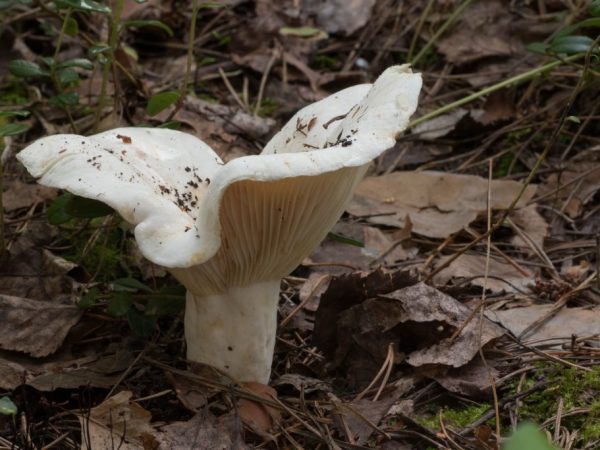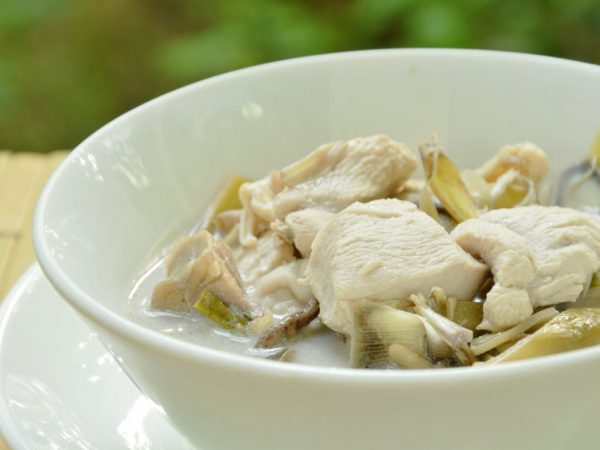Features of mushroom loading
Many different types of mushrooms grow in the forests of Russia, but the mushroom is especially popular among them. It is edible and tastes great and is used in both cooking and medicine.

Features of mushroom loading
Description
The podgruzdok has the taste, aroma and description that real milk mushrooms have.
Product Features:
- the surface of the cap is pleasant to the touch, dry and velvety;
- a hat without a fringe at the edges (such a fringe is always present in milk mushrooms);
- reaches a height of 20-22 cm;
- young individuals have funnel-shaped caps;
- the lamellar part has a bluish tint;
- the pulp is fragile;
- a low, solid, cylinder-shaped leg (5-7 cm in height and up to 4 cm in diameter).
The spore powder is white. There is no juice, like the milkmen, the pulp at the break remains white.
Lovers of podgruzdki collect them in deciduous forests, in conifers, the collection time is from July to October. Smoky, whitish-brown caps hide deep under the fallen leaves at the base of the trees. To find them you will have to work hard.
They grow in small families. Worms and forest parasites do not like them, so the harvest can be harvested unharmed.
Views
All podgruzdki belong to the Syroezhkov family, despite their external resemblance to milk mushrooms. The most popular types are:
- often lamellar;
- blackening and black;
- white.
White podgruzdok
Edible podload, white or dry, does not emit milky juice on the cut.
Description of the organism:
- dry hat with brown spots;
- the surface diameter reaches 20 cm;
- thin plates;
- the color of the plates is greenish, whitish or with a blue tint;
- the color of the pulp at the break does not change;
- the short leg reaches 5 cm.

The hat of the white load grows up to 20 cm
The old mushroom has a hollow stem. The type of White Podgruzdok, or Dry Podgruzdok is distinguished by the rare placement of plates. The old representatives of the species have an exceptionally brown hat.
Frequent lamellar
The type of Podgruzdok is often lamellar (thick-leaved) is sometimes called "nigella" because of its characteristic appearance:
- a brown hat that changes color with age;
- the diameter of the cap is 10-12 cm;
- the surface is dry in adults and covered with mucus in young ones;
- the pulp turns red and black on the cut;
- the young leg is white, then it darkens.
The aroma and taste are weak. A light edge on the cap is characteristic at any age of the fungus. The cap is bare in old mushrooms, cracking. Most often, nigella occurs from August to October in the European part of the Russian Federation. Prefers broad-leaved forests for the formation of mycorrhiza.
Black and blackening load
The popular black mushroom is found in the coniferous and deciduous forests of the temperate zone of Russia.
It differs from other types by the following description:
- rare and thick yellowish plates;
- dense pulp on the cut has a red or brick tint;
- the taste is pleasant, without pungency;
- the leg is dense;
- the size of the leg is from 3 to 7 cm in height and up to 3 cm in diameter.
Irina Selyutina (Biologist):
It is better to collect a black pickup while it is young, because this mushroom is susceptible to the "invasion" of worms - the older, the more wormy. The taste of the mushroom is low; it retains the smell of damp earth for a long time, reminiscent of the smell of mold. The pulp is sweetish, slightly spicy. The plates have a pungent taste. The black podgruzdok belongs to the IV taste category. After soaking and heat treatment, the pulp becomes black, the smell disappears, but the sweetish taste remains. After processing, old mushrooms do not improve their qualities - they become tough and tasteless.
The black load often has doubles:
- podgruzdok is often lamellar (thick-leaved): it is characterized by the fact that its cap is often adorned with adherent plates, the taste is excessively pungent, the smell is earthy;
- podgruzdok black and white (russula white and black): the mushroom was named for the "ability" of the cap to change color during the growth process.
The type of Podgruzdok blackening on the pulp has black streaks. The hat changes its color from gray to brownish-black. This is where the name comes from. Massively bears fruit from late July to mid-October.
Beneficial features
Loads have a lot of useful properties important for the human body, due to the chemical composition, which includes such important elements:
- vitamins of group B, A, P and PP;
- zinc;
- copper;
- manganese;
- ergosterol;
- amino acids;
- cellulose;
- stearic acid;
- chitin.
Vitamins strengthen the body, support it during viral epidemics. The amino acids in proteins act as a natural barrier against bacteria. Fiber contributes to normal bowel function.
Contraindications

Mushrooms are contraindicated for problems with the gastrointestinal tract.
Excessive amounts of chitin accumulate in these forest organisms. Especially there is a lot of it in the legs. Because of this, this product is considered difficult for digestion, and therefore people suffering from diseases of the gastrointestinal tract should use it with caution.
When harvesting, it is important to adhere to simple rules, for example, not to collect loads near busy highways, settlements, landfills or factories. Mushrooms are natural sponges and absorb all harmful substances from the environment: exhaust gases, radionuclides, etc. When the crop harvested in dangerous places is consumed, severe poisoning occurs, similar to poisoning by poisonous mushrooms.
Elderly people, pregnant women and young children are better off eating "forest meat" in moderation and after consulting a doctor.
Application
Loadouts are widely used in various spheres of human life: in cooking, medicine, pharmaceuticals and dietetics.
In cooking
Mushrooms contain more phosphorus than fish.
Culinary experts are happy to use different types of them for making salty snacks, pickling. Soups with this product have a bright, pronounced taste and aroma.
In the Volga region, they like to salt the load in a dry way and use such preparations all winter.
Mushrooms with onions, sour cream, fried in sunflower or olive oil, are served both as a main dish and as a side dish for meat or fish.
In medicine and pharmaceuticals
Scientists have isolated ellagic acid from the load of blacks. Its derivative, isolated in 2004, was named nigrikacin. It is a powerful anti-cancer agent and is used in the treatment of cancer. In addition, it was found that the fungus contains substances with antioxidant and antibacterial properties.
To suppress the growth of Ehrlich's carcinoma, an extract of white lumps infused with alcohol at a dosage of 300 mg / kg is used.
These forest organisms have high antimicrobial properties that are used to create medicinal ethanol extracts. It is effective against gram-positive bacteria and viruses. For your information. Gram-positive bacteria are called bacteria, the cells of which are stained according to a method developed by the Danish microbiologist H.K. Gram.
In traditional Chinese medicine, nigella is used for cramps to relax muscles.
A large amount of protein and antioxidants helps to lower blood sugar, therefore, foods are indicated for patients with diabetes mellitus.
Conclusion
It is important to take precautions when picking mushrooms. You cannot take mushrooms near the roads, you cannot walk into the forest without means of protection against mosquitoes and ticks, without a knife and a compass, you should carefully sort out all the collected specimens and part with suspicious ones without pity, or even better - not take them.



